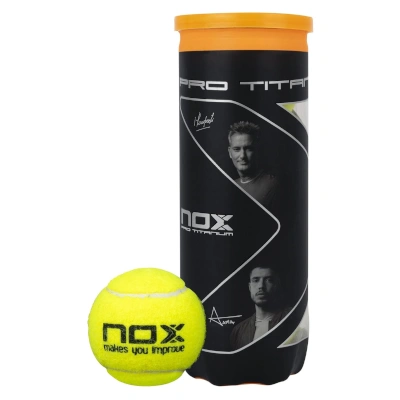The best padel balls stand out with consistent bounce, high durability, and a playing speed that suits your style. In our latest padel ball review, we took a close look at various models – from training balls to premium balls designed for tournament play. Whether you’re a beginner or an advanced player, we’ll show you only good padel balls that perfectly match your skill level and court conditions.
The Best Padel Balls in our Test
HEAD Padel Pro S
WINNER
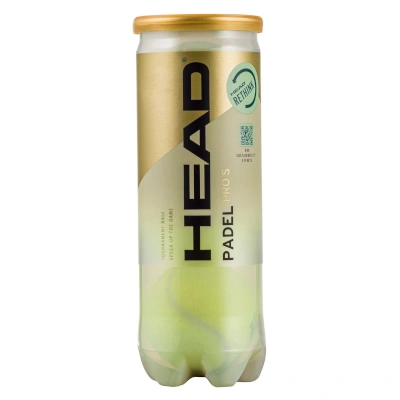
$9,99
- HIGH BOUNCE
- DURABLE FELT QUALITY
- CONSISTENT PRESSURE LEVEL
- TOURNAMENT-PROVEN
- SUITABLE FOR ALL COURT SURFACES
HEAD Padel Pro
BESTSELLER
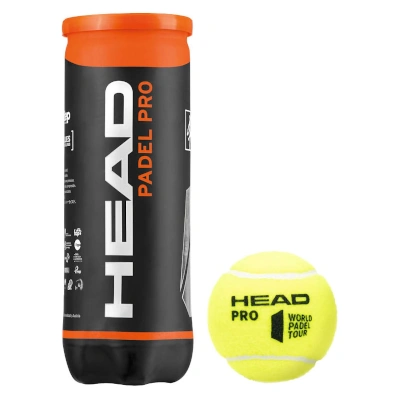
$11,67
- PERFECT CONTROL
- DURABLE FELT QUALITY
- BALANCED BOUNCE
- TOUR-TESTED
- IDEAL FOR ALL SKILL LEVELS
Dunlop Pro Padel
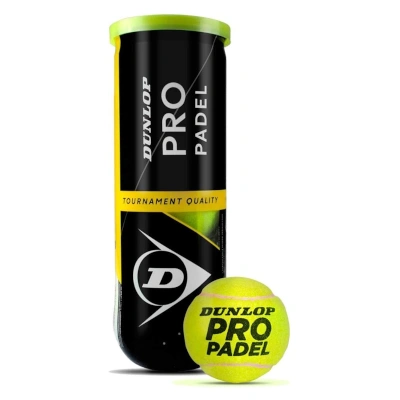
$16,98
- EXTRA DURABLE
- PRECISE FLIGHT CHARACTERISTICS
- PREMIUM FELT QUALITY
- REDUCED PRESSURE LOSS
- FOR TOURNAMENT AND CLUB PLAYERS
Adidas Speed RX
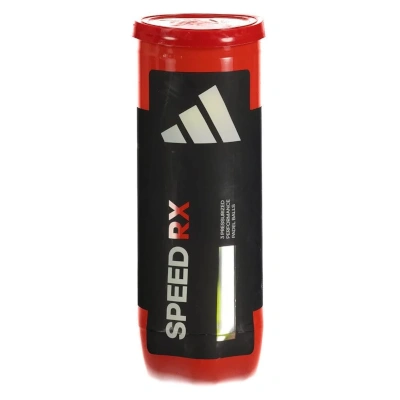
$12,70
- VERY HIGH SPEED
- OPTIMAL BOUNCE PERFORMANCE
- LOW-FRICTION FELT
- HIGH PRESSURE STABILITY
- TOP CHOICE FOR OFFENSIVE PLAYERS
NOX 3 Pro Titan
BEST VALUE
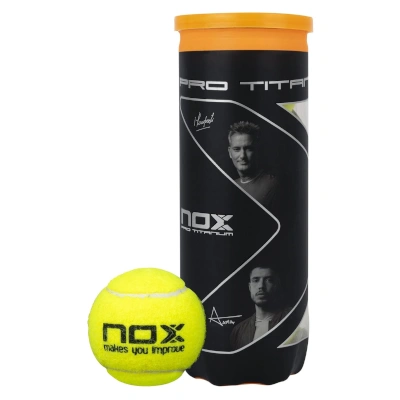
$13,87
- POWERFUL REBOUND
- DURABLE CONSTRUCTION
- STABLE PRESSURE CORE
- PROFESSIONAL QUALITY
- BALANCED PERFORMANCE
Wilson Padel Rush 100
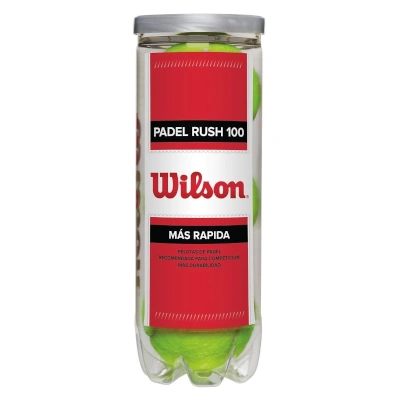
$12,99
- CONTROLLED REBOUND
- PRESSURELESS CORE
- EXTREMELY DURABLE
- SOFTER FEELING
- GREAT FOR TRAINING
Jump to:
The Best Padel Balls | Our 2025 Top Picks
A good padel ball makes all the difference – whether you’re training or competing. Speed, bounce behavior and durability not only influence the course of the game but also significantly affect your personal playing experience. The best padel balls stand out with consistent performance, high-quality felt and pressure characteristics tailored to your skill level. Beginners should opt for long-lasting, easy-to-control models, while ambitious players usually prefer more pressurized, faster balls that unleash their full potential during intense rallies.
In our comprehensive padel balls test, we present the most popular models from various brands, highlight their strengths and weaknesses, and help you find the ideal ball for your playing style, purpose and court surface.
Current Price: $9,99
A tournament ball for ambitious players who value speed, precision, and a lively playing feel – good padel balls for fast-paced rallies at the highest level.
- HIGH BOUNCE
- DURABLE FELT QUALITY
- CONSISTENT PRESSURE LEVEL
- TOURNAMENT-PROVEN
- SUITABLE FOR ALL COURT SURFACES
- LESS CONTROL FOR BEGINNERS
- TOO BOUNCY ON VERY WARM COURTS
Type: Pressurized tournament ball
Speed: Very high – ideal for fast rallies
Rebound: Lively and explosive
Felt: Durable premium felt for consistent spin
Best use: Perfect for indoor courts and cold conditions
Pressure stability: Maintains consistent level for approx. 2–3 matches
HEAD Padel Pro S Review
Taking first place in our padel ball test, the HEAD Padel Pro S is impressing with its high bounce and consistent performance. Increased internal pressure delivers a particularly dynamic playing feel, while the high-quality felt ensures a stable flight path and good durability. These balls are the official match balls of the World Padel Tour and are optimized for fast-paced rallies.
In practice, the HEAD Padel Pro S proves to be a top choice for offensive players. Its lively rebound allows for powerful shots, while still offering enough precision for accurate placements. Advanced players especially benefit from the speed and professional playing characteristics.
With a price of under $10 per 3-ball can, the Pro S are currently the best padels ball for ambitious players. However, it’s less suitable for beginners, as its fast game behavior demands a certain level of technique. As our test winner, the HEAD Padel Pro S impresses with speed, consistency, and tournament-level quality.
2. Rank | HEAD Padel Pro

Current Price:
The classic choice for frequent players who value control, consistency, and well-balanced playing characteristics – ideal for matches on any surface.
- PERFECT CONTROL
- DURABLE FELT QUALITY
- BALANCED BOUNCE
- TOUR-TESTED
- IDEAL FOR ALL SKILL LEVELS
- NOT QUITE AS FAST AS PRO S
- FELT MAY WEAR OUT FASTER ON SAND COURTS
Type: Pressurized standard ball
Speed: Balanced with good control
Rebound: Stable and predictable
Felt: High-quality, durable tournament felt
Best use: Versatile – suitable for matches and training
Pressure stability: Solid durability over approx. 3 matches
HEAD Padel Pro Review
Second place in our test take the HEAD Padel Pro – a tried-and-true classic known for its balance and reliability. Used in international tournaments for years, this ball impresses with its stable flight and durable felt. Even during longer matches, its bounce remains consistent.
In our 2025 padel ball comparison, the HEAD Padel Pro proves to be a true all-rounder. It offers a well-balanced mix of control and speed without any extreme tendencies – making them the best padel balls for intermediate recreational players looking for a dependable ball across various court surfaces.
Priced at around $14 per 3-ball can, the HEAD Padel Pro delivers a strong overall package. Suitable for both training and competitive matches, its controllable playing characteristics also make it a great option for players with a versatile style. A well-earned second place in our ranking.
Current Price: $16,98
Robust, reliable, and long-lasting: Dunlop Pro Padel balls are the right choice for intense training sessions and regular use at the club.
- EXTRA DURABLE
- PRECISE FLIGHT CHARACTERISTICS
- PREMIUM FELT QUALITY
- REDUCED PRESSURE LOSS
- FOR TOURNAMENT AND CLUB PLAYERS
- SLIGHTLY FIRMER FEEL
- SLIGHTLY DAMPENED REBOUND IN COLD WEATHER
Type: Pressurized competition ball
Speed: Medium to fast
Rebound: Direct with slightly firmer feedback
Felt: Abrasion-resistant high-density felt
Best use: Ideal for frequent players and club use
Pressure stability: Above average – still playable after 4 matches
Dunlop Pro Padel Review
Third place in our test are the Dunlop Pro Padel balls – known for their durability and stable performance. Specifically designed for long-term use, they feature a long-lasting rubber compound and a consistent flight path. Even with intensive use, they retain their playing characteristics over many matches.
In terms of longevity, the Dunlop Pro Padel shows its true strengths in our padel ball test. With a slightly firmer feel, it offers more direct feedback when hitting – an advantage for experienced players who value precision. At the same time, it remains easy to control across different court surfaces.
At $11.99 per 3-ball can, these balls offer good value for money. If you play regularly and are looking for a reliable ball for training or club matches, the Dunlop Pro Padel is an outstanding choice. A well-deserved third place in our comparison – and one of the best padel balls for frequent players.
Current Price: $12,70
If you like to set the pace on the court, the Speed RX offers a powerful padel ball with direct feedback and explosive rebound – ideal for offensive players.
- VERY HIGH SPEED
- OPTIMAL BOUNCE PERFORMANCE
- LOW-FRICTION FELT
- HIGH PRESSURE STABILITY
- TOP CHOICE FOR OFFENSIVE PLAYERS
- LESS SUITABLE FOR BEGINNERS
- HIGH SPEED CAN LEAD TO MISTAKES
Type: Pressurized speed ball
Speed: Very high – specially designed for offensive players
Rebound: Fast with powerful bounce
Felt: Low-friction special felt for maximum speed
Best use: Especially suitable for cool weather or indoor play
Pressure stability: Noticeable pressure loss after 1–2 matches
Adidas Speed RX Review
The fourth place in our listing goes to the Adidas Speed RX, clearly aimed at players who thrive on speed. With their lively bounce and reduced friction thanks to a special felt, they enable fast, dynamic rallies – a real advantage, especially in cooler conditions.
In our test, the Speed RX shows what’s possible in terms of pace. They deliver an agile feel and are especially suited for offensive players who like to take the initiative and finish points quickly. Despite the high speed, they remain controllable – provided you’ve got the technique to match.
At $10.99 per 3-ball can, they rank among the best padel balls for those who favor quick reactions and powerful shots. Beginners might initially struggle with the rapid pace, but experienced players will appreciate the immediate feedback. A strong fourth-place finish for those ready to hit the turbo.
Current Price: $13,87
A versatile all-round ball with consistent performance on a wide range of surfaces – ideal for players who value reliability.
- POWERFUL REBOUND
- DURABLE CONSTRUCTION
- STABLE PRESSURE CORE
- PROFESSIONAL QUALITY
- BALANCED PERFORMANCE
- SLIGHTLY MORE EXPENSIVE THAN OTHER MODELS
- NOT AVAILABLE EVERYWHERE
Type: Pressurized all-round ball
Speed: Neutral, with balanced playing characteristics
Rebound: Consistent and reliable
Felt: Durable tournament felt with long lifespan
Best use: Universally suitable for all court surfaces
Pressure stability: Good durability over approx. 3 matches
NOX 3 Pro Titanium Review
The NOX Pro Titanium balls take fifth place, presenting themselves as solid all-rounders with high-quality construction. They offer a balanced mix of control, bounce, and durability – without standing out in any one category. Players with a versatile playing style will especially benefit from their adaptability.
These good padel balls impress with their even pressure distribution and robust build. The felt withstands heavy use, and the bounce remains consistent over multiple matches. They respond reliably to spin and are suitable for various court surfaces.
Priced at around $7.40 per 3-ball can, they’re among the best padel balls for players who don’t want to compromise on core quality. They’re neither extremely fast nor particularly soft – and that’s exactly what makes them a dependable choice for training and casual matches. A well-earned fifth place for those who value reliability.
6. Rank | Wilson Padel Rush 100
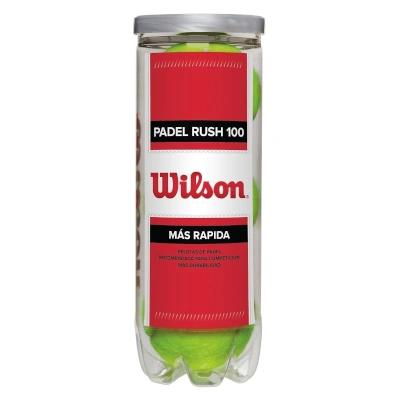
Current Price:
Thanks to its pressureless construction, it’s extremely durable and easy to control – the best padel balls for beginners, training sessions, and casual games.
- CONTROLLED REBOUND
- PRESSURELESS CORE
- EXTREMELY DURABLE
- SOFTER FEELING
- GREAT FOR TRAINING & RECREATIONAL PLAY
- LESS DYNAMICS AND SPIN
- DULLER PERFORMANCE DURING FAST RALLIES
Type: Pressureless training ball
Speed: Dampened and controlled
Rebound: Even, but less dynamic
Felt: Hard-wearing felt for long-term use
Best use: Optimal for beginners and technique training
Durability: Very high – usable over many training sessions
Wilson Padel Rush 100 Review
Finishing in last place, the Wilson Padel Rush 100 is a solid choice for beginners and casual players. As pressureless balls, they stand out for their durability and predictable bounce, making them ideal for longer training sessions or relaxed matches without competitive pressure.
In practical use, they feel less dynamic than other models but are extremely consistent. Even after many hours of play, they show hardly any drop in quality. The softer feedback is easy on the arm and racket – a clear advantage for beginners or players with sensitive joints.
At just $6.00 per 3-ball can, they’re among the best padel balls for getting started and offer great value. If you can do without high speed or tournament feel, you’ll get a reliable ball here for mastering the basics. A solid final spot that proves training balls absolutely have their place.
General Information About The Best Padel Balls in our Test | 2025
Different Types of Padel Balls (Training vs. Tournament Balls) | Best Padel Ball
Not all padel balls are the same – and if you play regularly, you’ll quickly notice how much speed, bounce, and control can vary depending on the model. To help you find the right ball for your skill level, purpose, and court conditions, it’s worth taking a closer look at the key differences. In the following sections, we’ll introduce the main types of padel balls and explain what really matters when choosing – from dynamic tournament balls to long-lasting training options.
1. Pressurized Balls
A dynamic option – popular among advanced players and in competitive play
Pressurized padel balls – similar to tennis balls – contain internal overpressure. This creates more bounce, faster gameplay, and an overall livelier ball feel. They are especially well-suited for tournaments, high-level matches, and players who prefer a dynamic game. Compared to other types, they offer the most professional playing characteristics, but they do need to be replaced regularly. If you value rebound, speed, and spin, pressurized models are hard to beat – though they come with the downside of limited durability. After just a few matches, the pressure noticeably drops.
2. Pressureless Balls
The long-lasting training option – durable, reliable, and ideal for beginners.
Pressureless balls are made of firmer rubber and contain no internal pressure. They retain their playing characteristics over a long period since there’s no pressure loss. While their bounce is less dynamic, they score points for durability and value for money. Ideal for daily training, schools, or recreational players with a slower pace. If you don’t want to constantly open new cans and are mainly working on technique, these offer a reliable solution. However, they’re usually too sluggish for competitive matches.
Difference Between “Regular” and Extra Fast Padel Balls | Best Padel Balls
Some brands offer their tournament balls in two versions: a regular model and an extra fast “speed” version. The main difference lies in the internal pressure – faster padel balls like the HEAD Pro S or Adidas Speed RX are slightly more pressurized, resulting in greater bounce and an even faster game pace.
These speed balls are specifically designed for slower court surfaces or cool weather conditions. On such courts, regular balls often feel sluggish – but with a faster model, gameplay remains dynamic and consistent regardless of the environment.
Even the product names and packaging designs often hint at a ball’s characteristics. For example, Head offers the popular HEAD Padel Pro as the standard version and the HEAD Padel Pro S as the faster variant. Differences can also be spotted in the can design or color coding – a detail experienced players often rely on.
→ Conclusion: If you frequently play under changing conditions or prefer a particularly fast-paced game, the speed version is the better choice. For stable conditions and a more controlled playing style, the regular version is usually more than enough.
Durability and Usage of the Best Padel Ball
Padel balls lose pressure relatively quickly after opening – especially pressurized models. After just a few hours of intense play, the bounce noticeably decreases. That’s why in professional tournaments, balls are replaced every 7 games. In recreational play, high-quality balls can usually maintain their performance for up to 3 matches before they start to feel softer.
A standard padel can contains 3 balls – and that’s completely sufficient. Unlike tennis, no balls remain unused on the court, as the entire floor is part of the playing area. This ensures a smooth and safe game flow. More than three balls would be unnecessary and would have to be stored in players’ clothing – which affects comfort and freedom of movement.
→ Conclusion: If you play regularly, you should plan on using a fresh can per match to ensure consistent quality. For casual players, good balls can easily last across multiple sessions.
Pressurized Containers and Storage: How to Make Your Padel Balls Last Longer
If you want to use your padel balls for longer, a pressurized container can make a big difference. These special containers restore internal pressure after playing, helping the balls retain their bounce and shape for a longer period. This not only saves money but is also environmentally friendly, as padel balls tend to have less surface wear than tennis balls, making them technically usable for a longer time.
Proper storage also helps extend lifespan: Balls should be kept at room temperature, protected from direct sunlight, and ideally stored back in their original sealed tube. This prevents the felt from drying out or the balls from deforming.
→ Tip: If you play regularly and value consistent ball quality, a pressure container is a smart long-term investment – and also contributes to sustainability.

